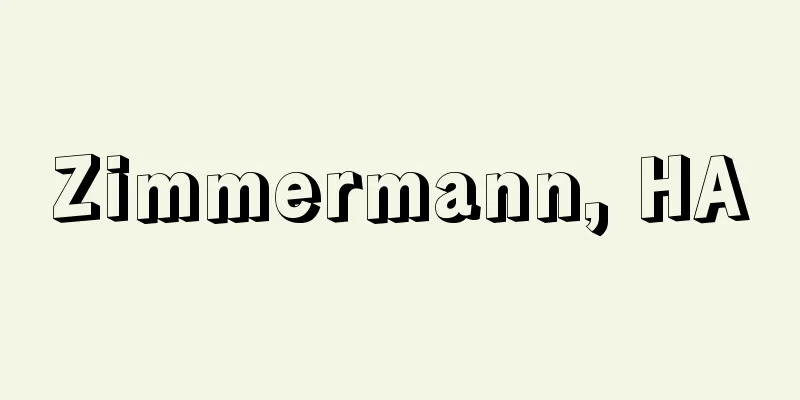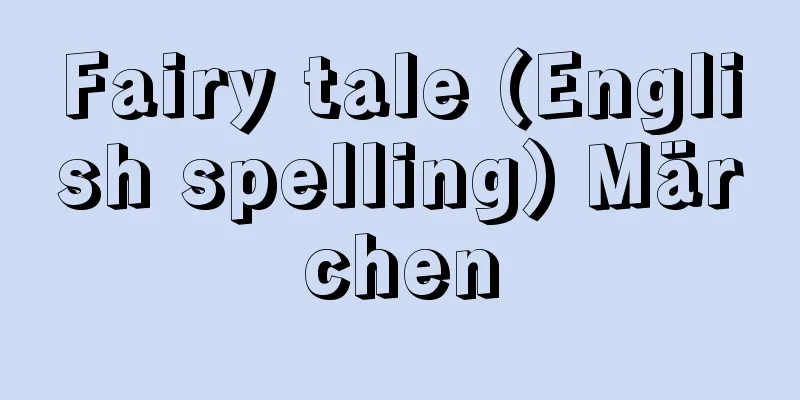German Theatre

|
A general term for German-language theatre, including Germany, Austria and parts of Switzerland, but historically extending to the wider German-speaking world. [Tatsuji Iwabuchi] Medieval theatreAround the 10th century, a form of music called tropes was born in churches, and at the same time, a dialogue-based liturgy began to be held at Easter, which gradually developed into the "Easter Play" (Osterspiel), which depicts the events before and after the resurrection of Christ as scenes from 14 Stations. This event eventually left the church and was passed on to the parishioners, the language used changed from Latin to German, and it became an outdoor play with simultaneous parallel stages (Simultanbühne) where each scene was set up in advance in the town square. The Christmas event also developed into the "Nativity Play" (Weihnachtsspiel), which deals with the events before and after the birth of Christ. These eventually became town-wide events, giving rise to large-scale "Passion Plays" (Passionsspiel), chronicling the life of Christ, which were frequently performed all over Europe from their peak in the 14th and 5th centuries through the 16th century. These religious plays are named after the towns where records of them remain, and in the German-speaking world, famous examples include the Easter plays of Muri in Switzerland, Erlau in Austria (now Eger in Hungary), the Redentin in Germany, and the passion plays of Frankfurt, Heidelberg, and Donaueschingen. Other religious plays include Marian laments, communion plays, hagiographical plays, and miracle plays, as well as dramatizations of secular tales with religious content, such as "Plays of Madame Jutah" and "Theophilus." [Tatsuji Iwabuchi] 15th-16th centuriesOn the other hand, spring festivals, which existed before the introduction of Christianity, were combined with carnival events to give birth to the farcical "carnival plays" (Fastnachtsspiel). Carnival plays were perfected in form in the mid-15th century, especially among the artisan class of Nuremberg, the center of commerce and industry, along with the "artisan songs" of the Meistersingers. In the 16th century, Hans Sachs wrote many works and was a representative German drama of the Renaissance. In the 15th century, humanists introduced Roman comedy (with the exception of the 10th century nun Roswitha's adaptation of Terence's plays), and writers who wrote Latin plays were born, and many polemical plays were written after the Reformation. However, these were not performed often, and instead "school plays" (Schuldrama) for Latin language practice were performed mainly on a simple stage called the Badezellenbühne (Terence stage) until the 16th century. The Counter-Reformation religious groups also performed plays for the purpose of evangelization, and the Jesuits in particular produced Biedermann, author of Zenodoxus, in the 16th and 17th centuries, and also performed many martyr plays. These plays, which preach happiness in the afterlife, reflect a Baroque sense of impermanence. [Tatsuji Iwabuchi] 17th centuryThe 17th century Baroque period also saw the development of theatre rich in emotional elements. Excessive rhetoric was favored in literature, and the introduction of opera led to the development of stage sets using perspective with peepholes. The idea of the "baroque theatre" - that no matter how small the stage, it could represent the whole world - was also related to the holding of large-scale festival processions. At the turn of the 17th century, a group of English actors came to Germany and introduced Elizabethan theatre, giving birth to professional actors in Germany. Italian commedia dell'arte troupes also came to Germany, giving birth to uniquely German clowns such as Hans Wurst and Harlekin, and a vulgar traveling theatre company with clowns at the center was established. However, the first half of the 17th century was a slump overall due to the Thirty Years' War, and Silesia, which was relatively spared from the war, only produced the literary theory of Opitz and the plays of Grueffius, and Germany had to accept its fate as a backward country in theatre compared to France, where classical theatre was well established. [Tatsuji Iwabuchi] 18th centuryIn the 18th century, the Age of Enlightenment, the scholar Gottschedt aimed to establish a high-class theater, and in cooperation with Madame Neuber's theater company, attempted to stage literary plays in Leipzig, introducing French classical theater theory. However, his attempt was merely imitation, and it was Lessing who truly embodied the Enlightenment spirit. Lessing criticized classical theater theory from the standpoint of the newly emerging citizen theater, defended Bürgerliches Trauerspiel, or "civil tragedies," with contemporary citizens as protagonists, and wrote masterpieces such as "Miss Sarah Sampson" and "Emilia Galotti." At that time, there was a growing call among German intellectuals for the realization of a national theater, and after Felten, such savvy actors as Ackermann and Eckhof emerged, and in 1767, the first national theater was opened in Hamburg by citizen volunteers, and Lessing participated in this. "The Hamburg Theater" is a theoretical work based on the practice of this time. Although this attempt failed within two years, the significance of the movement was great, and many court theaters, including the Burgtheater, were opened in the 1770s. In the 1770s, the Sturm und Drang (Storm and Drang) movement arose among the younger generation. This movement rebelled against the rationalism of the Enlightenment, preaching the primacy of emotion, contrasting natural human feelings with rational institutionalization, praising the genius Shakespeare, and attacking the rule-bound French classical drama. Plays such as Goethe's Götz von Berlichingen, Lenz's The Soldiers and The Governess, and Klinger's The Storm and the Storm were produced, and Schiller's The Robbers marked the end of the movement. However, this movement was in decline around 1781, when the enlightened Lessing published Nathan the Wise, a play on tolerance. Goethe took a classical stance after being welcomed to the Weimar court, and from the 1790s he worked with Schiller to establish a classical style in German drama. Schiller's late classical tragedies, Maria Stuart and Wallenstein, and Goethe's Iphigenie and Tasso were all performed at the Weimar court theatre, but the stylised acting of the Weimar theatre was in conflict with the realistic acting of the sentimental citizen theatre that was popular at the time. [Tatsuji Iwabuchi] 19th centuryIn the early 19th century, the "Romanticism" movement, which sought to integrate reason and irrationality, was born, centered around the Schlegel brothers. However, in the field of theater, it was only successful in the performance of Shakespeare's plays and the genre of fatalistic tragedies, and even the pioneering works of Tieck, which made full use of romantic irony and the destruction of illusions, remained within the realm of literature. Rather, the works of Kleist, which could be considered a side stream, offer a glimpse into the abyss of the unknowability of the modern individual. In Vienna, Austria, a unique folk theater style called "Haupt-und Staatsaktionen," a parody of historical dramas featuring clowns, developed from the Baroque period, but in the 18th century, Singspiel (plays with songs) and magic plays (fairy plays) were born mainly in the downtown area, and in the first half of the 19th century, folk playwrights such as Raimund and Nestroy were produced. Separate from these, Grillparzer left behind literary plays. The 19th century was the age of pseudo-classical writers who followed in the footsteps of Goethe and Schiller, and in inverse proportion to the prosperity of the theater, there was nothing worth seeing in their plays. Hebbel tried to reconstruct the idea of tragedy by introducing a Hegelian view of history, but historical plays in verse imitating Schiller were generally well received in the cultured court theaters, while the entertainment-oriented commercial theaters that flourished from the middle of the 19th century demanded the mass production of well-made plays. Freytag's "The Art of Drama" (1863) is a typical playwright's manual of this era. The plays of Grabbe and Büchner were highly contemporary, but were ignored until the end of the 19th century because they were far ahead of their time. [Tatsuji Iwabuchi] From the end of the 19th century to the 20th centuryThe festival dramas that Wagner started in Bayreuth in 1876 were of great significance as they were the realization of the theory of the comprehensive art of music drama. The historical productions by the Duke of Meiningen's (Georg II) troupe also became widely known through their European tours (1874-1890), and served as a stimulus for the birth of a new type of drama. In the 1880s, the social dramas of Ibsen appeared in Scandinavia, and theater was given a new function of social criticism. The so-called modern drama movement was linked to naturalism in literary history, and techniques of approaching the truth using methods of natural science observation and analysis were attempted in drama as well. The free theater movement that began in France spread to Germany, and in 1889 Brahm established the members-only "Free Stage" (Freie Bühne) in Berlin, introducing Hauptmann to the world with the social drama "Before Sunrise," and staging works by Ibsen, Holtz, Schraff, and others. Hauptmann's "The Weaver" is a typical work of crowd drama and environmental drama. Eventually, naturalistic drama became too obsessed with depicting reality and fell into trivialism, and as a result of moving too far away from theatricality in the acting, the stage became flat. In response to this, new trends such as Neo-Romanticism, Impressionism, and Symbolism emerged at the end of the century, and Schnitzler and Hofmannsthal in particular developed their own unique theatrical worlds in Vienna. The person who realised this trend in terms of direction was Reinhardt, known as the "Magician of the Theater." He was a pioneer of new theatrical spaces, expanding the theatrical space from small theaters to circus tent, and experimenting with mime theater, musical theater, and festival theater, but during the heyday of Expressionism, he returned to verbal theater. Expressionism, which appeared in the visual arts around 1910, rejected the surface depiction of naturalism and sought expression from the depths of the soul, but in theater it manifested itself in the destruction of illusion, the reduction to simple language, abstraction, and universalization. Pioneers of Expressionist theater include the comedian Sternheim, G. Kaiser, known as the playwright of thought, and Wedekind, who advocated sexual liberation through grotesque exaggeration. Then, the younger generation, including R. Sorge, R. Goering, Hasenklefer, and Unruh, began to write typical Expressionist plays that exhibited various characteristics such as scream plays, personal plays, and telegram-style plays, and after World War I, Expressionist plays such as director Jessner's staircase stage and Martin's revolutionary play "The Changes" by Toller swept across Germany. Piskartl was also a pioneer of agit-pro and political theater, using the stage for left-wing political education. However, by the second half of the 1920s the storm of enthusiastic Expressionism had passed, and instead "Neue Sachlichkeit" (New Objectivity), based on contemporary facts, rose to prominence, giving rise to new realist plays by F. Bruckner, Zuckmayer and others. Meanwhile, Brecht sought his own unique "epic theatre" (Episches Theater), but it was only after his exile that he perfected the technique of the V-Effect. E. V. Horbat and Fleisser, who emerged just before the Nazi era with new people's theatre criticising the masses, ended up not being recognised for their true worth. [Tatsuji Iwabuchi] After World War IIAfter the Second World War, apart from Borchert with Outside the Door, no newcomers emerged for a while, and Brecht and Zuckmayer, who had returned from exile, attracted attention, but the vacancy among newcomers was filled by M. Frisch and Dürrenmatt from Switzerland. After the division of East and West Germany in 1949, F. Wolf and others were active in East Germany under the Socialist Realism line, while Brecht's work with the Berliner Ensemble attracted worldwide attention. Furthermore, Hax, Heiner Müller, Braun, Hein and others developed Brecht's dialectical theater. In the former West Germany, from around the 1960s onwards, playwrights who showed a stance of political participation became active, and the genre of "documentary theatre" (Dokumentarisches Theater) by Weiss, Hochhuth, Kiphardt and others gained international acclaim. On the other hand, playwrights who took the position of absurdist theatre, such as Hildesheimer, also appeared. Around the time of the student revolution in 1968, young playwrights born in the 1940s appeared, but Handke, who experimented with "pure language theatre" (Sprechstück), was rather negative about political participation. Following the rediscovery of Horbert's folk theatre, Sperl, R. W. Fassbinder, Kretz and others began their activities. However, from the 1970s onwards, there was a growing sense of political frustration and introversion, and works by Both Strauss, who captured the sense of loss well, and Bernhard, who visualized a world of ruin, were often performed. Just before his death, Bernhard became more active in the theme of pursuing war responsibility. However, Strauss, who started out as part of the 1968 generation, wrote works that explored the hollowness of modern life when West Germany began to turn inward, but in the 1990s he began to criticize left-wing bias and write classical plays with a conservative tendency to re-establish order. In terms of directing, the activities of P. Stein and Grüber of the Schaubühne theater company, which started out as a collective production company, as well as Peimann and the non-German Jew Tabori, are also noteworthy, but the work of the latter is seen as a restoration of sensibility. This trend, as can be seen from the founding of the genre of "dance theater" (Tanztheater) by Pina Bausch (1940-2009), shows, shows the generalization of the idea of theater as a performance of body language. In the 1980s, postmodern theatrical phenomena became evident in German theater, where the emotionalization of theatrical figuration and the deconstruction and destruction of drama formed a single trend. H. Muller's Hamletmachine (1977) was a pioneering phenomenon in the deconstruction of plays, and as a playwright he produced successors such as R. Getz, but as directors, Schlöf and Castorf attracted attention for their dramatic destruction. The activities of female playwrights and directors have also been a notable phenomenon since the 1980s. In particular, the theatrical worlds created by Austrian actors Jerlinek and Ströllubitz are intense, and the activities of female directors such as A. Bred, who became director of the Schaubühne, and actress-turned-director Thalbach are conspicuous. The collapse of East Germany and German unification had various consequences for the theater world. The burden of financial aid for the reconstruction of the former East Germany had negative effects such as cuts in theater subsidies and the merging and closing of theaters, and the bankruptcy of Eastern European socialism caused political plays like those by Brecht (enlightening theater in a broad sense) to lose their appeal. However, the expectations placed on H. Muller, who broke with Brecht and set out on a different path, were a phenomenon that symbolized the theater world after unification, and the sense of loss following his death (1994) was also extraordinary. With the 100th anniversary of Brecht's birth (1998) as a turning point, the answer to which parts of Brecht's work will be inherited and developed will gradually become clear. If one were to sum up the characteristics of German theater in one sentence, it might be expressed as the paradox that tradition is found within an innovative attitude that destroys tradition. [Tatsuji Iwabuchi] "German Theatre in the Age of the Reformation - A Consideration of Its Historical Development" by Nagano Fujio (1962, Sobunsha)" ▽ "The Logic of Anti-Real Theatre" by Iwabuchi Tatsuji (1972, Kawade Shobo Shinsha)" ▽ "Modern German Theatre" by Miyashita Keizo (1973, Keio Tsushin)" ▽ "German Theatre in the Baroque Era" by Nagano Fujio (1974, Toyo Publishing)" ▽ "German Theatre in the Age of Enlightenment - Lessing and Her Era" by Nagano Fujio (1978, Toyo Publishing)" ▽ "Studies on German Civic Theatre" by Nakamura Motoyasu et al. (1986, Sanshusha)" ▽ "History of German Theatre" co-authored by Michael and Diver, translated by Yoshiyasu Mitsunori (1993, Hakusuisha) [References] | | | | | |Source: Shogakukan Encyclopedia Nipponica About Encyclopedia Nipponica Information | Legend |
|
ドイツ語を用いた演劇の総称。ドイツ、オーストリアおよびスイスの一部を含むが、歴史的にはさらに広範なドイツ語圏地域にまで及んでいる。 [岩淵達治] 中世演劇10世紀ごろ、教会でトロープス(交誦(こうしょう))といわれる形式の音楽が生まれ、それと並行して対話体による典礼が復活祭に行われるようになり、しだいにキリスト復活前後の事件を14の留(りゅう)Stationの場面として描く「復活祭劇」(オスターシュピールOsterspiel)に発展した。この行事はやがて教会を離れて教区の住民の手に移り、使われることばもラテン語から民衆語であるドイツ語にかわり、町の広場に各場面をあらかじめセットした同時並列舞台(ジムルタンビューネSimultanbühne)による野外劇になった。また降誕祭の行事もキリスト生誕前後の事件を扱う「降誕祭劇」(ワイナハツシュピールWeihnachtsspiel)に進展した。これらはやがて町全体の行事となり、キリストの生涯を年代記的に描く大規模な「受難劇」(パッションスシュピールPassionsspiel)を生み出し、14、5世紀を頂点に16世紀にかけて、ヨーロッパ各地で盛んに上演された。このような宗教劇は記録の残っている町の名でよばれるが、ドイツ語圏では、スイスのムリ、オーストリアのエルラウ(現ハンガリーのエゲル)、ドイツのレデンティンの復活祭劇、フランクフルト、ハイデルベルク、ドナウエッシンゲンの受難劇などが有名である。このほか、マリア哀歌、聖体拝領劇、聖人伝劇、奇跡劇などの宗教劇、宗教的な内容をもつ世俗説話を劇化した『ユタ夫人の劇』や『テオフィールス』などがある。 [岩淵達治] 15~16世紀一方、キリスト教伝来以前から存在した春祭が謝肉祭の行事と結び付いて、茶番狂言的な「謝肉祭劇」(ファストナハツシュピールFastnachtsspiel)が生まれた。謝肉祭劇は、15世紀中ごろ、とくに商工業の中心であったニュルンベルクの職人階級のなかで、マイスタージンガーMeistersingerの「工匠歌(こうしょうか)」と並んで形式的に完成された。16世紀にはハンス・ザックスが多くの作品を書き、ルネサンス期のドイツ演劇を代表した。また15世紀には人文主義者たちによってローマ喜劇が紹介され(10世紀の修道尼ロスウィータのテレンティウス翻案劇は例外)、ラテン語劇を書く作家も生まれ、宗教改革以後は多くの論争劇が書かれた。しかし、これらはあまり上演されず、もっぱらラテン語の練習のための「学校劇」(シュールドラマSchuldrama)が16世紀にかけて、浴房舞台(バーデツエレンビューネBadezellenbühne)(テレンティウス舞台)とよばれる簡素な形式の舞台で上演された。反宗教改革側の教団でも布教のために演劇が行われ、とくにイエズス会では16、7世紀に『ツェノドクスス』の作者ビーダーマンを生み、多くの殉教者劇も上演された。来世の幸福を説くこれらの劇には、バロック的な無常感が反映している。 [岩淵達治] 17世紀17世紀のバロック時代は、一方では感性的な要素に富む演劇を発達させた。文学的には過剰な修辞が好まれ、オペラの導入によって覗(のぞ)き見舞台をもつ遠近法を利用した舞台装置が発達した。この「バロック演劇」の、舞台はいかに狭くとも全世界を表しうるという世界劇場の理念は、大規模な祝祭行列の催しとも関係をもっている。 16世紀末から17世紀にかけての変わり目の時代には、イギリス俳優団が渡来してエリザベス朝劇を紹介し、ドイツに職業俳優を生む契機をつくった。またイタリアのコメディア・デラルテの一座が入ってきて、ハンスウルストやハレルキンHarlekinなどドイツ固有の道化も生まれ、道化を中心とする低俗な巡回劇団が成立した。しかし、17世紀前半は三十年戦争の戦場となったため全体に振るわず、比較的戦禍を免れたシュレージエンでオーピッツの文学理論やグリューフィウスの戯曲を生んだにすぎず、古典主義演劇の確立したフランスに比べて、演劇の後進国の運命を甘受することになった。 [岩淵達治] 18世紀18世紀の啓蒙(けいもう)時代に入ると、学者ゴットシェットが高尚な演劇の確立を目ざし、ノイバー夫人の劇団と提携してライプツィヒで文学的な戯曲の上演を試み、フランスの古典劇理論を紹介した。しかし、彼の試みは模倣にすぎず、真に啓蒙精神を体現したのはレッシングであった。レッシングは新しく台頭した市民劇の立場から古典劇理論を批判し、同時代の市民を主人公とする「市民悲劇」Bürgerliches Trauerspielを擁護して、『ミス・サラ・サンプソン』や『エーミリア・ガロッティ』などの傑作を書いた。当時ドイツの知識人の間には国民劇場実現の声が高まり、またフェルテン以後アッカーマンやエクホーフなどの識見ある俳優も生まれて、ハンブルクでは1767年に市民有志によって初めて国民劇場が開場し、レッシングもこれに参加した。『ハンブルク演劇論』はこのときの実践を踏まえた理論的著作である。この試みは2年足らずで挫折(ざせつ)したが、運動としての意義は大きく、1770年代に入りブルク劇場をはじめ、多くの宮廷劇場が開設された。 1770年代には、若い世代の間からシュトゥルム・ウント・ドラングSturm und Drang(疾風怒濤(どとう))の運動がおこった。この運動は、啓蒙時代の理性中心主義に反発して感情の優位を説き、合理的な制度化に自然な人間感情を対置し、天才シェークスピアを賞賛して規則ずくめのフランス古典劇を攻撃した。ゲーテの『鉄手のゲッツ・フォン・ベルリヒンゲン』、レンツの『軍人たち』『家庭教師』、クリンガーの『疾風怒濤』などの戯曲が生まれ、シラーの『群盗』がその掉尾(とうび)を飾った。しかし、啓蒙家レッシングが寛容の劇『賢者ナータン』を発表した1781年ころにはこの運動も退潮していた。ゲーテはワイマールの宮廷に迎えられてから古典的な立場をとるようになり、1790年代からはシラーと協力してドイツ演劇に古典的な様式を確立しようと努めた。シラー晩年の古典悲劇『マリア・ストゥアルト』『ワレンシュタイン』、ゲーテの『イフィゲーニエ』『タッソー』などはすべてワイマールの宮廷劇場で上演されたが、ワイマールの様式的演技は当時流行した感傷的な市民劇の写実的演技と対立するものであった。 [岩淵達治] 19世紀19世紀初頭には、シュレーゲル兄弟を中心に理性と非合理を統合しようとする「ロマン主義」運動がおこった。しかし、演劇の分野ではシェークスピア劇上演や運命悲劇のジャンルで成功したにすぎず、ロマン的皮肉(イロニー)や幻想(イリュージョン)破壊を駆使したティークの先駆的作品も文学の範囲内にとどまった。むしろ傍流ともいえるクライストの作品に、近代的な個の不可知性の深淵(しんえん)がのぞいている。 オーストリアのウィーンでは、バロック時代から、道化の登場する歴史劇のパロディー「ハウプト・ウント・シュターツアクチオーネン」Haupt-und Staatsaktionenという独自の民衆劇が発達したが、18世紀には下町を中心にジングシュピールSingspiel(歌入り芝居)や魔法劇(妖精(ようせい)劇)が生まれ、19世紀前半にはライムント、ネストロイなどの民衆劇作家を生み出した。これらとは別に、グリルパルツァーが文学的な劇作品を残した。 19世紀は、ゲーテ、シラーの後を受けた擬古典的な亜流作家の時代であり、劇場の隆盛と反比例して戯曲にはみるべきものがない。ヘッベルはヘーゲル的な史観を導入して悲劇の理念を組み替えようと試みたが、概して教養的な宮廷劇場ではシラーを模倣した韻文の歴史劇が歓迎され、一方、19世紀なかばから盛んになった娯楽的な商業劇場では、ウェルメイドプレイの量産が求められた。フライタークの『戯曲の技巧』(1863)は、この時代の典型的な劇作の指南書である。グラッベやビュヒナーの戯曲が優れて現代的でありながら19世紀末まで無視され続けたのは、彼らがはるかに時代を先取りしていたためであった。 [岩淵達治] 19世紀末から20世紀へ1876年ワーグナーがバイロイトで開始した祝祭劇は、楽劇という総合芸術論の実現であり、大きな意義をもった。またマイニンゲン公(ゲオルク2世)一座の歴史的演出は、ヨーロッパ巡演(1874~1890)によって広く知られ、新しい演劇誕生の刺激となった。 1880年代になると、北欧のイプセンの社会劇が出現し、演劇は社会批判という新しい機能を与えられた。いわゆる近代劇運動は文学史上の自然主義と結び付き、自然科学的な観察や分析の手法を用いて真実に迫る技法がドラマにおいても試みられた。フランスに始まる自由劇場運動はドイツにも及び、ブラームは1889年ベルリンに会員組織制の「自由舞台」(フライエビューネFreie Bühne)を発足させ、社会劇『日の出前』でハウプトマンを世に送り、イプセン、ホルツ、シュラーフなどの作品を上演した。ハウプトマンの『織工(おりこ)』は、群集劇、環境劇の典型的作品である。やがて自然主義劇は現実描写にこだわるあまり些末(さまつ)主義に陥り、また演技から芝居らしさを遠ざけすぎた結果、舞台は平板なものになっていった。これに対して、世紀末には新ロマン主義、印象主義、象徴主義などの新しい傾向が生まれ、とくにウィーンではシュニッツラー、ホフマンスタールが独自の劇世界を展開した。演出の面でこの傾向を実現したのは、「劇場の魔術師」とよばれたラインハルトである。彼は新しい演劇空間の開拓者であり、小劇場からサーカス小屋まで劇空間を拡大し、マイム劇や音楽劇、祝祭劇まで試みたが、表現主義全盛期にはかえってことばの演劇に回帰した。 1910年前後から美術に現れた「表現主義」(エクスプレショニスムスExpressionismus)は、自然主義の表面描写を退けて魂の内奥からの表現を求めたが、演劇においてはイリュージョンの破壊、単純な言語への還元、抽象化、普遍化の傾向となって現れた。喜劇作家シュテルンハイム、思考の遊戯者といわれたG・カイザー、グロテスクな誇張によって性の解放を訴えたウェーデキントなどは表現主義演劇の先駆者である。ついでR・ゾルゲ、R・ゲーリング、ハーゼンクレーファー、ウンルーなどの若い世代が絶叫劇、私戯曲、電報体などとよばれる諸特徴を示す典型的な表現主義劇を書き始め、第一次世界大戦後には演出家イェスナーの階段舞台や、マルチン演出によるトラーの革命劇『変転』などの表現主義舞台が全ドイツを席巻(せっけん)した。またピスカートルはアジプロ劇や政治演劇の先駆者として、舞台を左翼的な政治教育に用いた。 しかし、1920年代後半には熱狂的な表現主義の嵐(あらし)は去り、かわって今日的事実に依拠した「新即物主義」(ノイエ・ザハリヒカイトNeue Sachlichkeit)が台頭して、F・ブルックナー、ツックマイヤーなどの新しいリアリズム劇が生まれた。一方、ブレヒトは独自の「叙事演劇」(エーピッシェステアーターEpisches Theater)を模索していったが、異化効果Ⅴ‐Effektの手法を完成したのは亡命以後である。ナチス時代の直前に大衆を批判する新しい民衆劇で登場したE・v・ホルバートやフライサーは、真価を認められぬままで終わった。 [岩淵達治] 第二次世界大戦後第二次世界大戦後は、『戸口の外で』のボルヒェルト以外はしばらく新人が登場せず、亡命地から帰国したブレヒトとツックマイヤーが注目されたが、新人の空位はスイスのM・フリッシュとデュレンマットによって埋められた。1949年の東西ドイツ分裂以後、東ドイツでは社会主義リアリズム路線のもとでF・ボルフらが活躍し、一方では劇団「ベルリーナー・アンサンブル」Berliner Ensembleで活動を開始したブレヒトの仕事が全世界の注目を集めた。さらにハックスやハイナー・ミュラー、ブラウン、ハインらがブレヒトの弁証法的な演劇を発展させた。 旧西ドイツでは1960年代前後から政治参加の姿勢を示す劇作家が活躍するようになり、ワイス、ホーホフート、キップハルトらによる「記録演劇」Dokumentarisches Theaterというジャンルが国際的な評価を得た。一方、ヒルデスハイマーのような不条理演劇の立場をとる作家も登場した。1968年の学生革命の前後からは1940年代生まれの若い作家が登場したが、「純粋言語劇」(シュプレヒシュトュックSprechstück)の実験を行ったハントケはむしろ政治参加に否定的であった。ホルバートの民衆劇の再発見の線からはシュペル、R・W・ファスビンダー、クレッツらが活動を始めた。しかし、1970年代以後は政治的な挫折感と内向化が進み、その喪失感をよくとらえているボート・シュトラウス、破滅の世界を形象化するベルンハルトの作品がよく上演された。ベルンハルトは、死の直前には戦争責任追及のテーマに積極的になった。しかしシュトラウスは1968年世代的な出発をしながら、西ドイツの内向化傾向が始まると現代生活の空洞を探るような作品を書いていたが、1990年代には左翼偏向姿勢を非難し、秩序を再建するような保守傾向とともに古典的な劇を書くようになった。演出面では、集団創作から出発した劇団「シャウビューネ」SchaubühneのP・シュタインやグリューバー、また、パイマンやユダヤ系非ドイツ人タボリの活動も注目されるが、後者の仕事は感性の復権という方向でとらえられる。この傾向はピナ・バウシュPina Bausch(1940―2009)が「舞踏演劇」(タンツテアーターTanztheater)というジャンルを創始したことからもわかるように、演劇を身体言語のパフォーマンスととらえる考え方の一般化を示している。 1980年代にはドイツ演劇にもポストモダンの演劇現象が顕著になり、感性的な舞台形象化やドラマの解体や破壊現象がひとつの流れを形成する。H・ミュラーの『ハムレットマシーン』(1977)は戯曲の解体の先駆現象で、劇作家としてもR・ゲッツのような後継者を生んでいるが、演出家としても、シュレーフ、カストルフなどはドラマを破壊するような演出で注目を集めた。女性の劇作家や演出家の活動も1980年代からの注目すべき現象である。とくにオーストリア出身のイエリネック、シュトレールービッツの作り出す劇世界は強烈であり、シャウビューネの監督になったA・ブレート、女優出身のタールバッハなど女性演出家の活躍が目だつ。 東ドイツの崩壊とドイツ統一は演劇界にさまざまな結果をもたらした。旧東ドイツへの再建財政援助の負担が、演劇助成の減額、劇場の統廃合などというマイナス効果を生み出し、また東欧型社会主義の破産がブレヒトのような政治的な劇作品(広い意味で啓蒙的な演劇)の魅力を失わせることになったが、ブレヒトと決別して別の道を歩き始めたH・ミュラーに寄せられた期待はまさに統一後の劇界を象徴する現象であり、彼の死(1994)の後の喪失感も異常であった。ブレヒト生誕100年(1998)を契機に、どの部分が継承発展されるのかという解答も徐々に示されていくだろう。 ドイツ演劇の特質をひとことで総括するならば、伝統を破壊する革新の姿勢のなかに伝統があるという逆説で表現できるかもしれない。 [岩淵達治] 『永野藤夫著『宗教改革時代のドイツ演劇――その史的発展の考察』(1962・創文社)』▽『岩淵達治著『反現実の演劇の論理』(1972・河出書房新社)』▽『宮下啓三著『近代ドイツ演劇』(1973・慶応通信)』▽『永野藤夫著『バロック時代のドイツ演劇』(1974・東洋出版)』▽『永野藤夫著『啓蒙時代のドイツ演劇――レッシングとその時代』(1978・東洋出版)』▽『中村元保他著『ドイツ市民劇研究』(1986・三修社)』▽『ミヒァエル、ダイバー共著、吉安光徳訳『ドイツ演劇史』(1993・白水社)』 [参照項目] | | | | | |出典 小学館 日本大百科全書(ニッポニカ)日本大百科全書(ニッポニカ)について 情報 | 凡例 |
<<: German-Austrian Alliance - German-Austrian Alliance
>>: German films - German films
Recommend
Leszek Bialy (English spelling)
...The divisions stimulated regional competition,...
Kakuma [Hot Spring] - Kakuma
...The town occupies the Yomase River basin, a tr...
Geotrygon
… Most species live mainly in trees. However, the...
Desorption
…For example, when carbon dioxide dissolves in wa...
Sudhana
…The protagonist of the chapter Entering the Real...
Boulanger, L. (English spelling) BoulangerL
…French composer and music educator. She studied ...
Government - Kougi
1. Public matters. 2. The Imperial Court, also the...
Lower attack - Shigasane
A type of clothing worn by male nobles. It is wor...
Electronic scale (electronic balance) - Denshibakari (English spelling) electronic scale
A general term for scales that incorporate electro...
"Kikuchi Otomo's Sleeve Mirror"
...The "Seigen Anshitsu" that has been ...
Morning and evening fortune telling - Asake Yuuke
...Fortune telling by standing at a crossroads an...
People's Liberation Army of China
The name of China's military. It is referred ...
Sethe, K. (English spelling) SetheK
...There is no unified text, and the spells used ...
Macaca fuscata yakui (English notation) Macaca fuscata yakui
…Monkey [Kuroda Sueju]. . . *Some of the terminol...
Strasburger, Eduard Adolf
Born: February 1, 1844 in Warsaw Died May 18, 1912...






![Minamikata [town] - Minamikata](/upload/images/67ccf3e46add4.webp)


